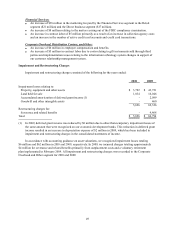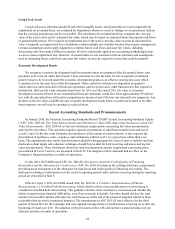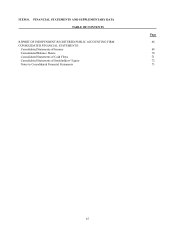Cabela's 2011 Annual Report Download - page 68
Download and view the complete annual report
Please find page 68 of the 2011 Cabela's annual report below. You can navigate through the pages in the report by either clicking on the pages listed below, or by using the keyword search tool below to find specific information within the annual report.58
In addition, our unsecured senior notes contain various covenants and restrictions that are usual and customary
for transactions of this type. Also, the debt agreements contain cross default provisions to other outstanding credit
facilities. In the event that we failed to comply with these covenants, a default would trigger and all principal and
outstanding interest would immediately be due and payable. At December 31, 2011, we were in compliance with all
financial covenants under our credit agreements and unsecured notes. We anticipate that we will continue to be in
compliance with all financial covenants under our credit agreements and unsecured notes through the next 12 months.
Our $15 million CAD unsecured revolving credit facility expires June 30, 2013, and permits the issuance of
up to $5 million CAD in letters of credit, which reduces the overall credit limit available under the credit facility.
Interest remains variable, is computed at rates which are defined in the agreement plus a margin, and is payable
monthly. All other terms of the credit agreement remained unchanged.
2010 versus 2009
Operating Activities – Cash derived from operating activities decreased $127 million in 2010 compared to
2009. This net decrease in cash from operations was primarily due to inventory growth from the new retail store
in Grand Junction, Colorado, and from more merchandise on hand than at the end of 2009 as we were focused on
maintaining sufficient core inventory heading into 2011. Inventory increased $69 million in 2010, to a balance of
$509 million, compared to a decrease of $78 million in 2009, or to a balance of $440 million. WFB paid cash out
on a net basis of $49 million for credit card loans originated at Cabela’s through our Retail and Direct businesses.
Current and deferred income taxes payable decreased $71 million compared to 2009, partially offset by increases
in unrecognized tax benefits and related accrued interest of $44 million and in current and deferred income taxes
recoverable of $15 million comparing 2010 to 2009. These net decreases were partially offset by an increase of
$66 million in the provision for loan losses.
Investing Activities – Cash used in investing activities increased $242 million in 2010 compared to 2009. In
2010, WFB purchased United States government agency securities totaling $350 million which matured during
fiscal 2010. In addition, WFB disbursed cash on a net basis for credit card loans originated externally at third
parties totaling $281 million in 2010. In 2009, WFB retained asset-backed securities totaling $75 million from
the $500 million Series 2009-I issuance of the Trust and purchased triple-A rated notes for $2 million from a
previously issued series of the Trust. Cash paid for property and equipment additions totaled $75 million in 2010
compared to $49 million in 2009. At January 2, 2011, we estimated total capital expenditures for the development,
construction, and completion of retail stores, including the purchase of economic development bonds, to
approximate $37 million through the next 12 months.
Financing Activities – Cash used in financing activities decreased $250 million in 2010 compared to 2009.
This net decrease was primarily due to the repaying of $289 million of secured variable funding Trust obligations
in 2010. We also had a decrease of $33 million in the change related to unpresented checks. Partially offsetting
these decreases was an increase in time deposits, which WFB utilizes to fund its credit card operations, of $36
million in 2010 compared to a net decrease of $8 million in 2009. Also, borrowings on our lines of credit for
working capital and inventory financing increased $20 million in 2010 compared to 2009. At the end of 2010 and
2009, there were no amounts outstanding on our unsecured revolving credit facility.
Economic Development Bonds and Grants
In the past, we have negotiated economic development arrangements relating to the construction of a number
of our new retail stores, including free land, monetary grants, and the recapture of incremental sales, property, or
other taxes through economic development bonds, with many local and state governments. Where appropriate, we
intend to continue to utilize economic development arrangements with state and local governments to offset some
of the construction costs and improve the return on investment of our new retail stores.
Economic Development Bonds – State or local governments may sell economic development bonds to provide
funding for land acquisition, readying the site, building infrastructure, and related eligible expenses associated with
the construction and equipping of our retail stores and certain other property. In the past, we have primarily been
the sole purchaser of these bonds. While purchasing these bonds involves an initial cash outlay by us in connection
























